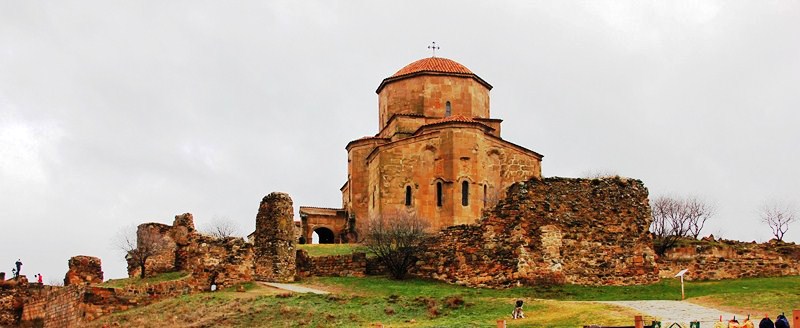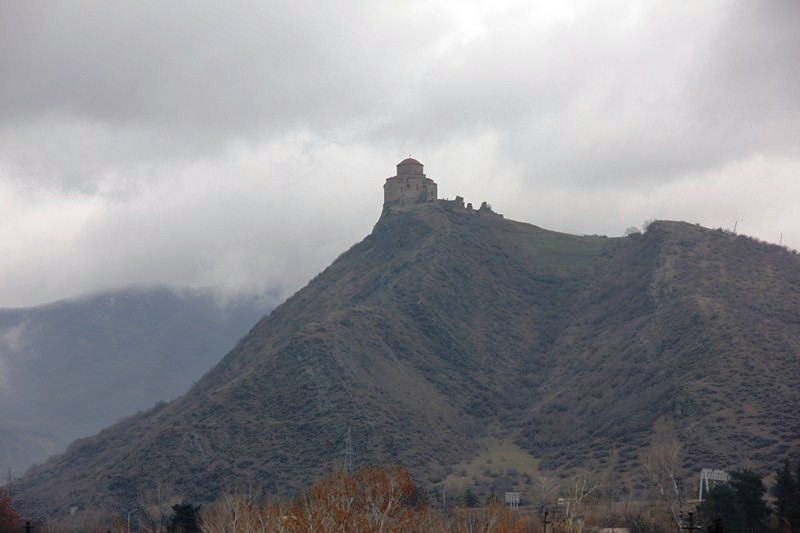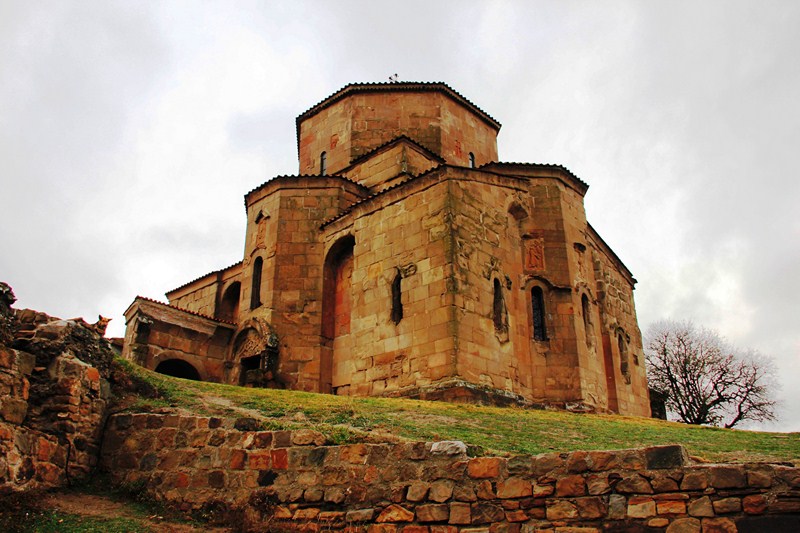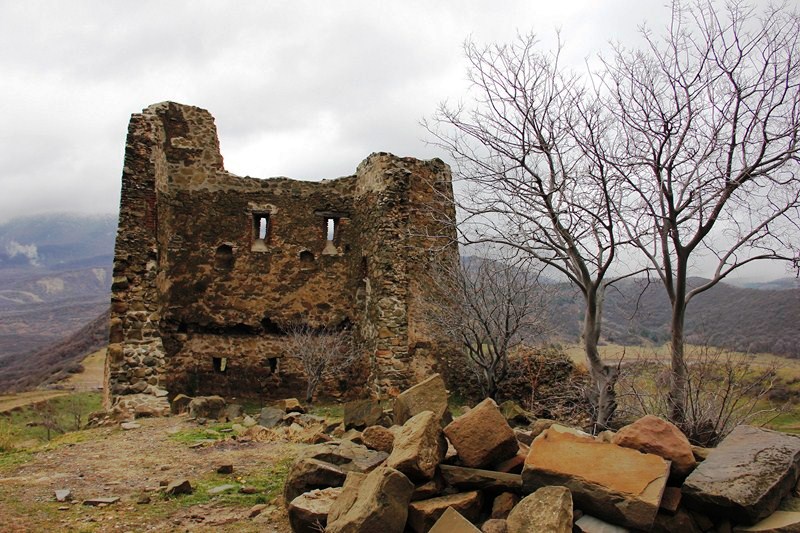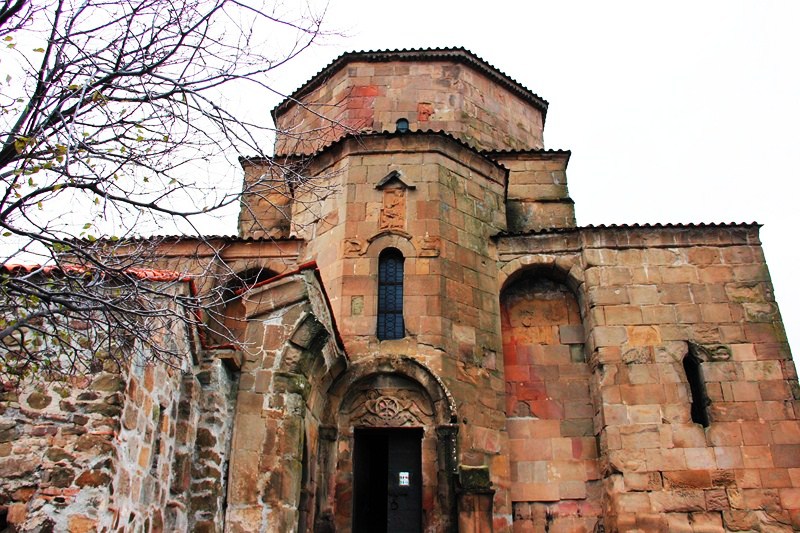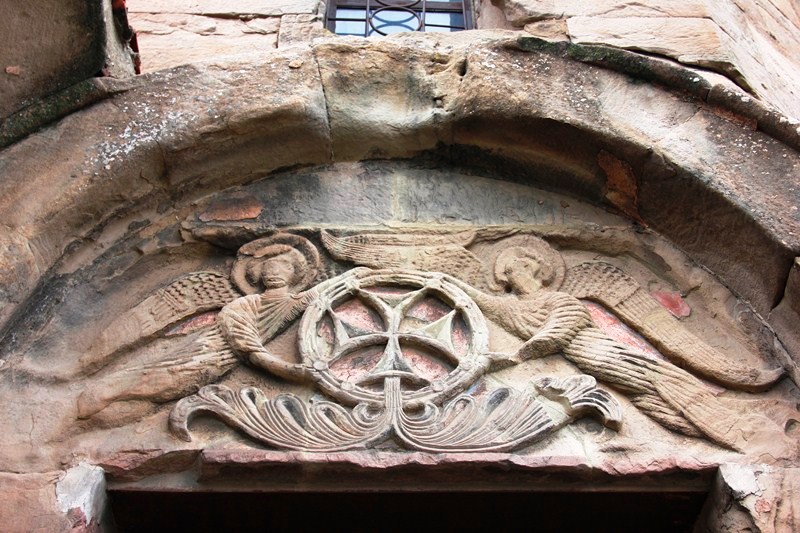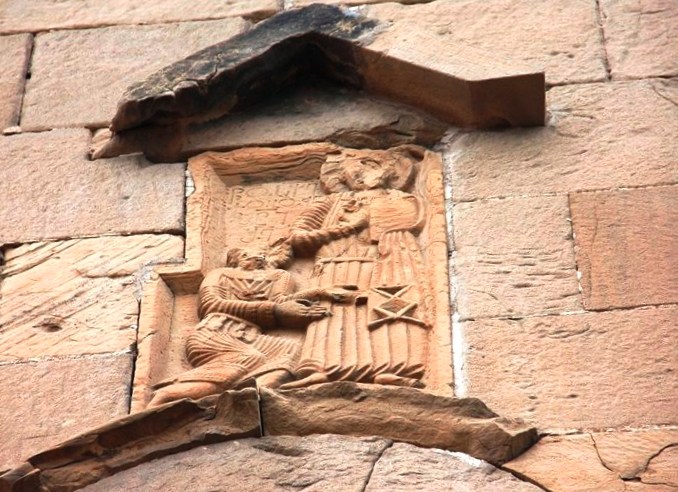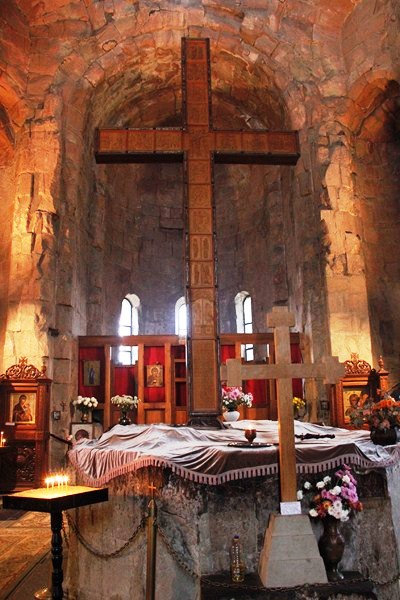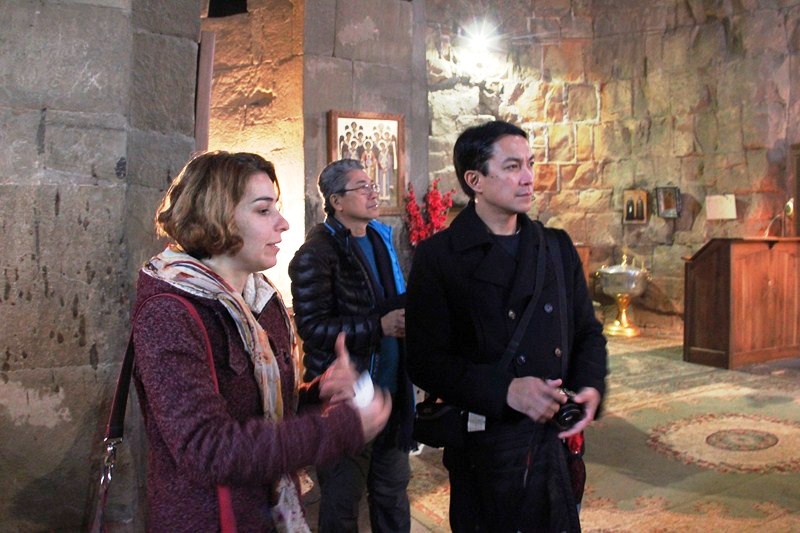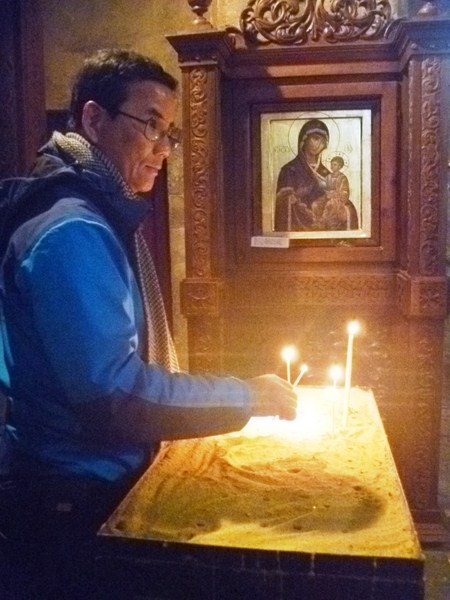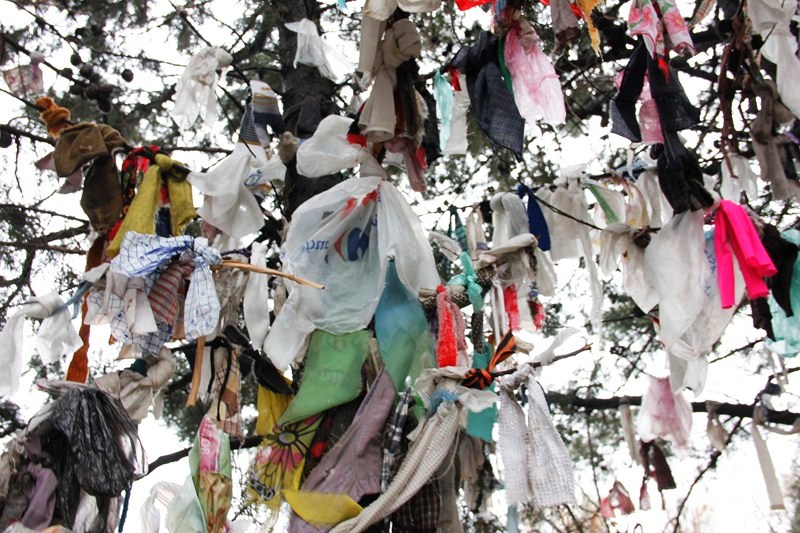It was the first day of our Georgian Countryside Tour, sponsored by the Georgian National Tourism Administration and, after breakfast, Buddy, Pancho, Melissa, Riva and I proceeded to Meidan Square where we met up with our affable Georgian guide – Ms. Sopho Makashvili. GNTA also provided us with a white Mercedes-Benz Sprinter panel van and a driver.
Our first destination was to be Jvari Monastery in the town of Mtskheta, just a 22 min. (20.6-km.) drive up north via the Tbilisi-Senaki-Leselidze Highway. Even from the main road, the church was already visible from afar as it is perched on top of a hill (the highest in the town) with splendid hues of orange, yellow, red and green. With its 1:7 size proportions, Jvari Monastery also looked like a head on the shoulders of the rock it was built on. We drove up almost to the monastery where there’s a small lot where cars can park for free.
According to traditional accounts, in the early 4th century, a large wooden cross, symbolizing the fall of paganism and rise of Christianity in Georgia, was erected over a pagan temple by Saint Nino, a female evangelist credited with converting King Mirian III of Iberia to Christianity. Pilgrims from all over the Caucasus were drawn to the cross after it was reportedly able to work miracles. In 545, just north of the cross, a cruciform church, known as the Small Church of Jvari, was built. Between 586 and 605, the larger and present”Great Church of Jvari” was constructed directly above the site of the wooden cross by Erismtavari Stepanoz I, the Presiding Prince of Kartli (Iberia).
During the Soviet period, the church was preserved as a National Monument, but access to it was very difficult due to tight security at a nearby military base. After the independence of Georgia in 1991, the building was restored to active religious use in 1996. In 2004, the monastery, together with other monuments of Mtskheta, were placed on the UNESCO World Heritage List, by the World Monuments Fund, as part of the “Historical Monuments of Mtskheta” and, in 2009, was added to the UNESCO List of World Heritage in Danger.
Entrance to the monastery is free of charge. The monastery complex is rather small and it was once fortified as remnants of a stone wall and a gate, built in the late Middle Ages, still survive to this day. From a viewpoint, we were rewarded with stunning views of of Mtskheta (the old capital of the ancient Kingdom of Iberia), with Svetitskhoveli Cathedral in its very heart; the Saguramos mountains and the amassing confluence of the the Aragvi and the Mtkvari (Kura) Rivers.
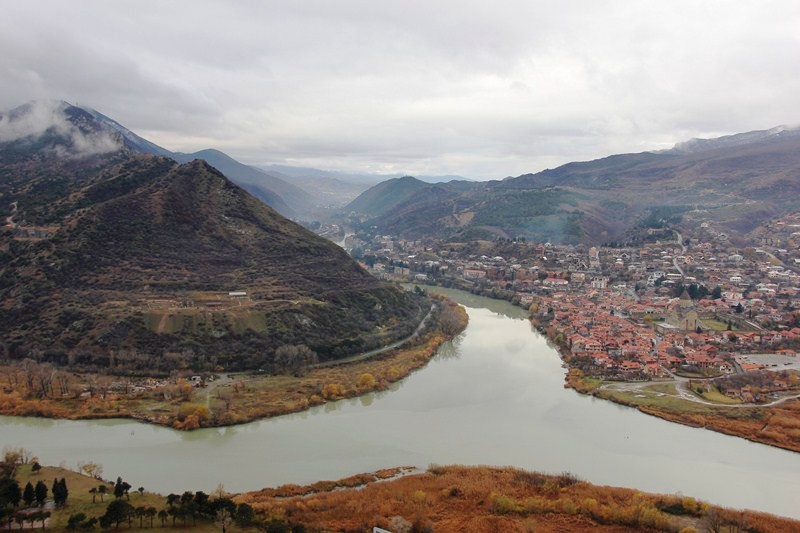
View of Mtskheta, the Saguramos Mountains and the confluence of the Mtkvari and Aragvi Rivers (photo: Ms. Riva Galveztan)
This picturesque view of these two rivers, “that are mixed like two sisters,” was described by the Russian classic poet Mikhail Yuryevich Lermontov (October 3, 1814 – July 27, 1841) in his poem “Mtsyri.” They say that when it is not very rainy, you can see clearly that both rivers have water of different colors: blue and dark blue.
The Church of the Holy Cross, a domed tetraconch, is an early example of a “four-apsed church with four niches,” a church design found in the architecture of Georgia, Armenia and Caucasian Albania. Often referred to as a “Hripsime-type plan” (after its best known example, the church of St. Hripsime in Armenia), this church had a great impact on the further development of Georgian architecture, serving as a model for many other churches. Three-quarter cylindrical niches, between the 4 apses, are open to the central space and 3 rows of squinches affect the transition from the square central bay to the base of the dome’s drum. The ruins of the Small Church of Jvari are still visible beside the church.
The church is also the first Georgian church where reliefs take a significant place in the décor of its external facades which is decorated with varied and exceptional bas-relief sculptures with Hellenistic and Sasanian influences, some of which are accompanied by explanatory inscriptions in Georgian Asomtavruli script. The fine proportions and remarkable technique of these relief sculptures distinguishes it from the sculptures from earlier bas-relief carving common in the region.
The entrance tympanum, on the southern façade, is adorned with a relief of the Glorification of the Cross and also shows an Ascension of Christ. On the facet of the drum of the dome is a figure of an unidentified person, possibly the architect. An inscription on the eastern facade mentions the principal builders of the church as Stephanos (patricius), his brother Demetre (hypatos) and son Adarnase (hypatos). Over the centuries, its stone blocks have been degraded, suffering damage from acidic rain, wind erosion and inadequate maintenance which all play a part in deteriorating the monastery.
Before we entered the church, the women had to cover their heads with scarves and a second one to wrap around the waist as a skirt (there were scarves available for visitors to quickly borrow). However, it seems that it is not very strictly enforced. We were also allowed to take photos inside the church but we avoided using our camera’s flash.
The rather rough and simple interior didn’t have any impressive frescoes or richly decorated altar, just the usual gorgeous icons (including one of St. Nino) and a huge, carved wooden cross (a replica of the original cross of St Nino) on its original octagonal base, but its simplicity suggested some peace and quiet. The inner height also made the church look very spacious. The high windows at the top of the church allows light to come through and cascade across.
On our way down the hill, we passed the monument of Russian poet Mikhail Lermontov on the right side and made a short stopover at the Tree of Wishes. A Georgian tradition, The pilgrims come there to fasten cloth ribbons or small pieces of canvas over its branches, with the hopes that their wishes will be granted.
The place, with its unique history, tranquility and unforgettable views, was truly fabulous. Though not large or ornate, the lovely Church of the Holy Cross is very attractive in a strong, simple way and an iconic site in the history of Georgian Orthodox Christianity. Many couples get married here.
Georgia National Tourism Administration: 4, Sanapiro St, 0105, Tbilisi, Georgia. Tel: +995 32 43 69 99. E-mail: info@gnta.ge. Website: www.georgia.travel; www.gnta.ge.
Qatar Airways has daily flights from Diosdado Macapagal International Airport (Clark, Pampanga) to Tbilisi (Republic of Georgia) with stopovers at Hamad International Airport (Doha, Qatar, 15 hrs.) and Heydar Aliyev International Airport (Baku, Azerbaijan, 1 hr.). Website: www.qatarairways.com.

